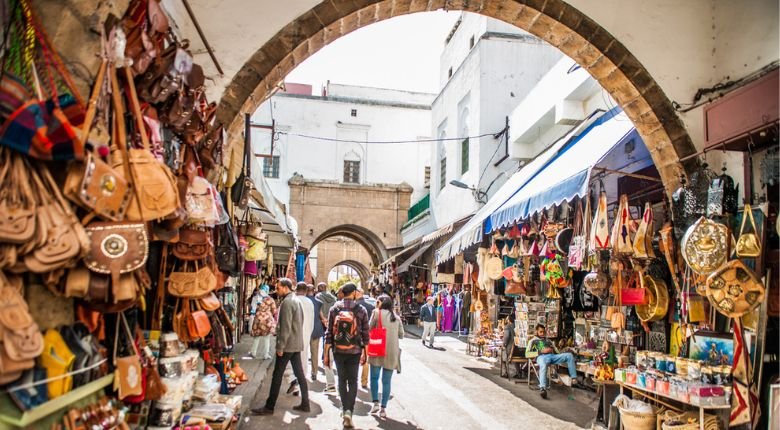Explore Morocco Food Tour Itinerary

Marrakech is a city in Morocco that is known for its rich history and culture, including its unique cuisine. The history of Marrakech’s food is intertwined with the city’s past, from its Berber roots to the Arab and Andalusian influences.
Berber cuisine, which is the traditional cuisine of the indigenous people of North Africa, heavily influenced the early food culture of Marrakech. This cuisine is based on simple, hearty ingredients such as meat, grains, vegetables, and spices. Some of the staple foods of Berber cuisine include couscous, tagines, and harira (a soup made with chickpeas and lentils).
Marrakech History
In the 11th century, Marrakech was founded by the Almoravids, a Muslim Berber dynasty. This marked the beginning of Arab influence on the city’s cuisine. Arabic dishes such as tagine (slow-cooked stew) and pastilla (a sweet and savory pastry) became popular in Marrakech, while local ingredients such as argan oil and saffron were incorporated into Arab dishes.
During the 13th century, Andalusian Muslims fleeing persecution in Spain settled in Marrakech, bringing with them their own culinary traditions. This led to the creation of new dishes such as bisteeya, a savory pastry made with pigeon meat, almonds, and spices. The Andalusian influence can still be seen in Marrakech’s cuisine today, particularly in the city’s sweets and pastries.
In the 16th century, Marrakech became the capital of the Saadian dynasty, which brought further culinary influences from the Ottoman Empire and Persia. These influences can be seen in dishes such as kefta (grilled meatballs) and mrouzia (a sweet and spicy lamb tagine).
Today, Marrakech’s cuisine is a blend of its Berber, Arab, Andalusian, Ottoman, and Persian roots. Traditional dishes such as tagine and couscous are still popular, while new dishes such as mechoui (slow-roasted lamb) and harira with lentils have emerged. Marrakech is also known for its street food, such as merguez (spicy sausage) and b’ssara (a fava bean soup). With its vibrant flavors and unique blend of culinary influences, Marrakech’s food history is a testament to the city’s rich cultural heritage.
Morocco Cuisine Tour Itinerary
Morocco is a country that is rich in history, culture, and cuisine. With a blend of Arab, Berber, and European influences, Moroccan cuisine is known for its vibrant colors, bold spices, and unique flavors. If you are planning a food tour to Morocco, here is an itinerary that will allow you to experience the best of Moroccan cuisine.
Day 1: Marrakech
Arrive in Marrakech and check into your hotel. In the evening, head to Djemaa el-Fna, the main square in the city, which comes alive at night with food stalls and street performers. Try some traditional Moroccan dishes such as tagine (slow-cooked stew), couscous, and harira (a hearty soup).
Day 2: Marrakech Mediana
Visit the Marrakech Medina, a UNESCO World Heritage site, and explore the maze of souks (markets). You can find a variety of spices, nuts, and dried fruits here. Take a cooking class and learn how to prepare traditional Moroccan dishes such as bisteeya (a savory pastry), mechoui (slow-roasted lamb), or pastilla (a sweet and savory pastry).
Day 3: Essaouira
Take a shared Marrakech desert tours to Essaouira, a coastal town located about 2.5 hours from Marrakech. Essaouira is known for its fresh seafood, and you can find some of the best seafood restaurants in Morocco here. Try some grilled sardines, shrimp, or squid. You can also visit the fish market and buy some seafood to cook at home.
Day 4: Fes
Travel to Fes, the cultural and spiritual capital of Morocco. Fes is known for its medina, which is the largest car-free urban area in the world. Take a guided food tour of the medina and try some local specialties such as babbouche (snail soup), camel burgers, and msemen (a type of pancake). Don’t forget to try the famous Fassi pastries such as sellou and chebakia.
Day 5: Fes ( Bou Inania Madrasa )
Visit the Bou Inania Madrasa, a beautiful 14th-century Islamic school, and then head to the famous tanneries, where you can see the traditional process of leather-making. You can also take a cooking class and learn how to make a traditional Fassi tagine or rfissa (a chicken and lentil dish).
Day 6: Chefchaouen
Travel to Chefchaouen, a picturesque blue-painted town located in the Rif Mountains. Chefchaouen is known for its goat cheese, which is used in many local dishes such as chermoula (a spicy sauce) and rghaif (a type of flatbread). You can also try some traditional Moroccan sweets such as shebakia and ghriba.
Day 7: Chefchaouen ( Mountains )
Take a hike in the Rif Mountains and enjoy the stunning views. You can also visit the Akchour Waterfalls and have a picnic with some traditional Moroccan snacks such as olives, dates, and pastries. In the evening, enjoy a traditional Moroccan dinner with live music and dancing.
Day 8: Departure
Say goodbye to Morocco and depart for home.
Moroccan cuisine is a true reflection of the country’s history and culture. From the bustling medinas to the picturesque mountains, this itinerary will allow you to experience the best of Moroccan cuisine and create unforgettable memories.
Reach out our article on Exploring World’s Beautiful Waterways




